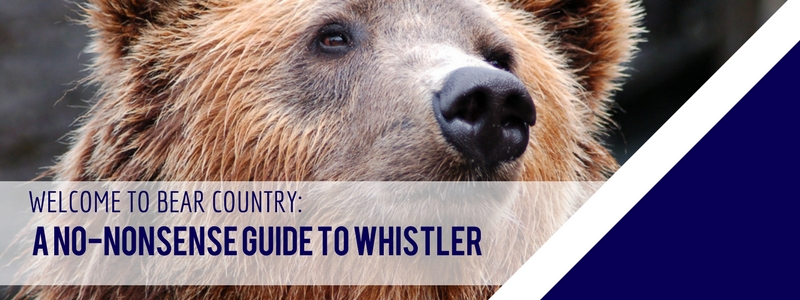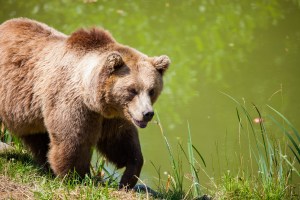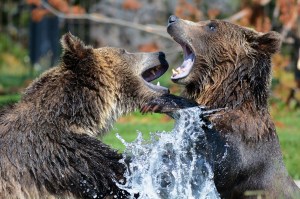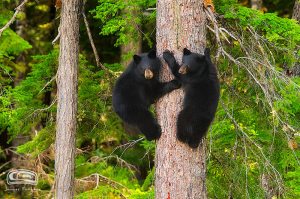Welcome to Bear Country: A Common Sense Guide to Whistler Bears

Welcome to Whistler, home of world-class skiing, epic mountain biking, and two species of bear. Whistler has grizzly bears and black bears both in the woods, and in our neighbourhoods. A fact which many visitors only find out about after their first encounter. And while living in the same neck of the woods as a large carnivore might put you on edge, we like to think under most circumstances, the Whistler community and the bear community get along quite well together.

Another day, another bear in Whistler
That doesn’t mean there aren’t some slightly scary encounters for newcomers and locals alike. Ask anyone at Forged Axe Throwing; we’ve got a tale or two about meeting a bear on the trail, in our backyard, or even on the hill. Our friendly mascot dog, Bandito, has even had his fair share of encounters, going to far as to jump on top of the bear in his excitement.
Because we know that most of you have never seen a bear, let alone met one in its natural habitat, we wanted to set up for success if you are lucky enough to see one in the wilds of Whistler. When it comes to bears, following a few rules and keeping some common-sense in mind can go a long way.
But we also understand that without growing up in bear country, it’s reasonable to assume you might need some assistance building up your common-sense natural reaction. If you haven’t already gone on a whistler bear tour, you might not know the basic rules. We’ve got you covered in this No-Nonsense Common-Sense Guide to Whistler Bear Country.
Hiking, Camping, Exploring, Oh My: Whistler Bear Safety
People flock to Whistler during all seasons to get the best the B.C. wilderness has to offer – but the real clutch time for hiking and camping in our area is in the spring and summer. Conveniently, that’s when our lovely bear friends come out of their hibernation period. Given their lengthy hibernation, they are very motivated by food. Luckily, bears are relatively predictable and habitual creatures, so the key to staying safe is following along with some fundamental guidelines to bear encounters.
Stay Calm

Contrary to popular belief, bears are skittish creatures
We know it’s hard to believe, but bears are not naturally malicious animals. In fact, they’re quite skittish, shy, and standoffish – dependant of course on your actions. Clear communication is a huge deal when it comes to bear-human interaction. Without words, it’s hard for bears and humans to let each other know they’re just frightened, not angry. Often miscommunication can result in an unpleasant situation.
The first thing you have to do when you see a bear is to stay calm. Don’t approach the bear ever – walking toward him can make him feel trapped. Then, as silly as it sounds, let the bear know what’s up. Talk to him in a calm voice, heck, introduce yourself if you want while you slowly and calmly back away.
“Hey, Mister bear, how’s it going?” back up, back up, back up, “I’m just out for a nice little stroll and didn’t mean to startle you,” back up, back up, back up.
A big loud and calm voice is essential. Despite your natural reaction, do not run, and, don’t make any sudden movements – the bear might perceive these as a threat.
Stay Out of Their Space

Keep your distance as much as possible.
Remember this is real life, you are not simply bear watching in Whistler. In the wild, bears have three F’s of motivation: food, family, and fear. Did you get him and a food source? This is a big deal, especially if it’s right before or after their hibernation period.
You also need to make sure there aren’t any cubs present. This is a big deal, too. Mother bears are known to be unusually aggressive when it comes to protecting their babies. The last thing you want to do is pose a potential threat to her cubs. Don’t mess with a bear and its space. Back up slowly, away from his escape route, or her cubs. A Whistler grizzly tends to want to avoid an aggressive situation as much as you do.
Make a Big Ruckus
If you encounter a black bear, and you’ve done everything we’ve already instructed, your ultimate step is to get loud. We don’t mean aggressive – don’t charge the bear or run into its territory. We just mean loud. Stand as tall as you can, look the bear in the eye, and shout something assertively at the bear.
It doesn’t matter what it is; you can yell anything from your credit score to the list of things your mother-in-law does to annoy you – whatever you say, just be loud, assertive, and fearless.
Get Bear Prevention Gear
Before heading out into the great outdoors, you should gear up with a few handy products that can help avoid any nasty encounters. Bear bells might sound like an exotic Canadian musical instrument, but they are in fact a bit of bear-avoidance technology that easily clips on your belt, bag of dog. Remember when we said bears are skittish? A bell is a perfect way to announce your presence well in advance of an encounter.
Another essential tool is bear spray. It’s a small canister similar to pepper spray, to carry with you while hiking and camping. If all else has failed, having bear spray within easy reach can be the last line of defense if a bear does charge you. Like pepper spray, it’s excruciating. Neither the bear or you want to get it in the face.
Check out the Escape Route before your next venture into the backcountry, as they always have bear spray and bear bells in stock.
Is the Bear in Your Backyard? Contact the Local Conservation Officer
Bears are commonplace in the woods of Whistler, but also in its urban neighborhoods. The food left out in campgrounds attracts them, and the grease on BBQs in backyards. They also love garbage; they have no shame.
Don’t be afraid to contact the local conservation office a call if you encounter a bear where he isn’t supposed to be. They are creatures of habit, and once they know your patio is a likely source of food, they’ll come back over and over again.
Check out Bear Smart Whistler

Bear Smart Whistler is a great resource
Want access to more bear safety rules and a great resource? The Bear Smart Whistler website is a great resource, give them a call, or schedule a visit. This organization exists to teach people about living with bears, creating smart bear communities, and exploring safely in bear country. They have plenty of activity-specific guides for bear safety, as well as resources to explain how to bear-proof your home.
How to Safely See Bears in Whistler
Spoiler alert: its by taking one of the many Whistler Bear tours. Taking a tour with a reputable company protects yourself and the bear from getting into an uncomfortable situation.
One of the best options for bear viewing is via Whistler Blackcomb Bear Tours. You can check out black bears in a vehicle, with a guide, and even take close, guided walks to bear feeding sites. These tours are typically available to the public May-October with a variance in price from about $198-$225.

Cubs as captured by Whistler Discovery Tours
Want more options? Check out bear tours with Whistler Discovery Tours. For a two-hour tour packed with travel through the Coast Mountain Range, you’ll pay about $120. You’ll have the chance to take tons of pictures, maybe see some black bears feed, and learn about how bears operate from their knowledgeable guides. This is also a great resource for bear safety!
Bear-able Common Sense
Maybe you didn’t grow up around bears, so these rules may not seem so common-sense after all — but fear not! We’re here to cover all the common-sense bear rules that you may not know about. These rules apply to locals and visitors alike.
Don’t leave your Garbage Out
Guys, we’re going to say it slow: Bears. Love. Garbage. Garbage-proof your homes, your trashcans, everything in your area that holds trash. Even we’ve had a hungry bear come looking for food at Forged Axe Throwing. We quickly learned our lesson.
https://www.youtube.com/watch?v=keGf5iN1pEU
If you’re hiking or camping, pack it in and pack it out – don’t leave trash! It’s just going to attract bears to the area. Also, if you’re hiking and camping and you have food, don’t forget to hang your food high in a tree. Leaving it on the ground is almost a direct invitation to a bear to come traipsing through your campground.
No Scents are Good Sense
Bears are driven by smell, so be very cautious about what you’ve got brewing. Things you wouldn’t think would attract bears (hello, citronella candles) do. Make sure you’re cautious about what scents you have out, which foods you’ve got around, and what trash is in your area. That also means keeping your fire pit clear of all foodstuff. Never, ever, ever keep your food in your tent. That’s like, saying “hey, bear, do you want to come in for a midnight snack?” And do we really want to invite the bear into the tent? We think not.
Hike in a Group
Bears are much less likely to approach or threaten you if you have an entire group with you, so make sure you’re traveling in numbers. A large group is less likely to see a bear, and a bear is less likely to approach a large group. Groups are loud and obnoxious, but that is a perfect way to warn a bear of your presence. They can hear you coming a mile away. Becuase they are skittish creatures by nature and will travel in the opposite direction.
Keep Your Dogs Leashed and Attended
A lot of people like to hike with their pets, and while we understand the sentiment, you’ve got to be extra careful when you do. Bears might just consider your dog a perfect midday meal. Always keep your dog on a leash and never leave your pet unattended. If you’re camping, do not leave your dog out at night. Bring that puppy in your tent with you.
